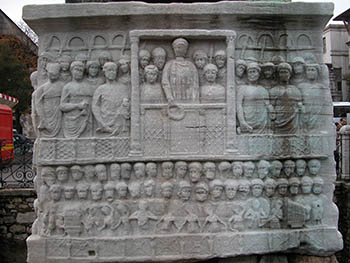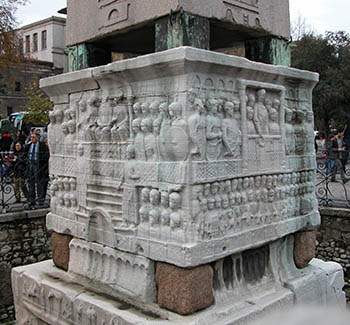Hippodrome statue bases of Porphyrios the greatest chairoteer of his age dating to 515
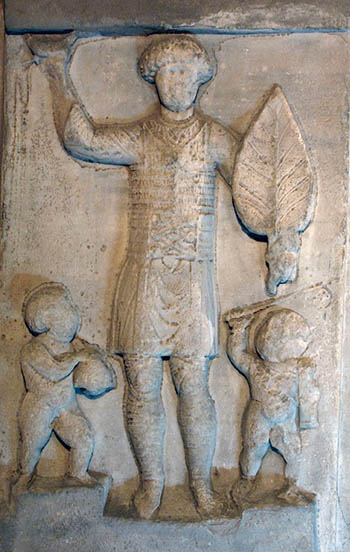
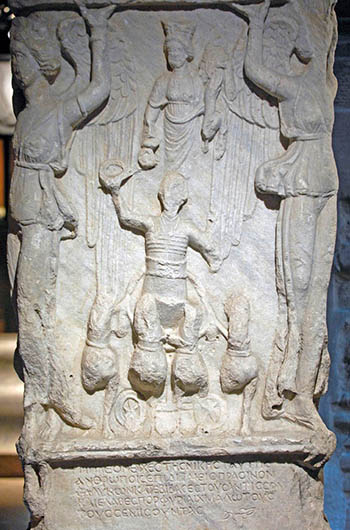
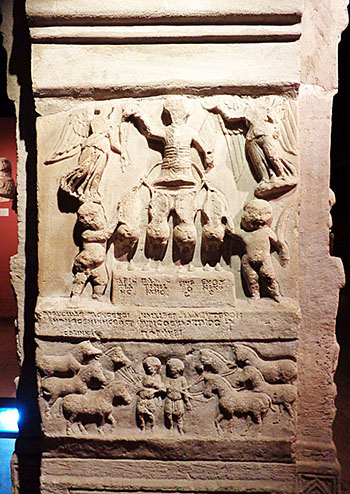

Journal of Sport History, Vol. 8, No. 3 (Winter, 1981)
by Barbara Schrodt
Ms. Schrodt is an Associate Professor in the School of Physical Education and Recreation at the University of British Columbia, Vancouver, British Columbia, Canada.
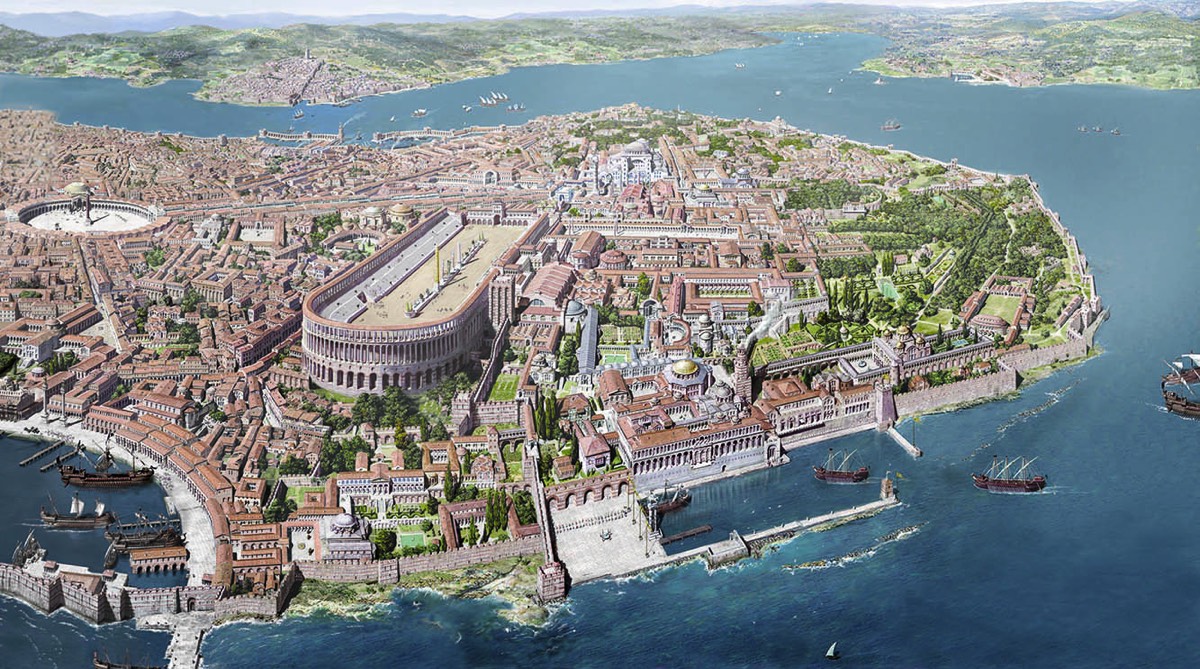 From the fourth century A.D. until the fall of Constantinople in 1453, the people of the Byzantine or Eastern Roman Empire participated in a wide range of sports and physical recreations. Most of these activities were inherited from Greek and Roman civilizations, or were introduced through contacts with Asia Minor and Crusading Europe. Some sport forms disappeared after a few centuries, while others remained a part of the sporting culture during most of the lifetime of this civilization. However, in spite of the longevity of the Byzantine Empire, and the importance attached to sport by its inhabitants, little has been written about that period in sport history references. Much of the information that is available gives the impression that sport in Byzantium consisted of nothing more that Roman activities transplanted to the shore of the Bosporus, while other sources simply refer to Byzantium in sections devoted to the final period of Greek athletics. This paper attempts to alter that situation by presenting a fuller description and interpretation of this topic, for close study reveals a period of sport history that was uniquely Byzantine — one that warrants more attention than it is usually given in English-language sport histories.
From the fourth century A.D. until the fall of Constantinople in 1453, the people of the Byzantine or Eastern Roman Empire participated in a wide range of sports and physical recreations. Most of these activities were inherited from Greek and Roman civilizations, or were introduced through contacts with Asia Minor and Crusading Europe. Some sport forms disappeared after a few centuries, while others remained a part of the sporting culture during most of the lifetime of this civilization. However, in spite of the longevity of the Byzantine Empire, and the importance attached to sport by its inhabitants, little has been written about that period in sport history references. Much of the information that is available gives the impression that sport in Byzantium consisted of nothing more that Roman activities transplanted to the shore of the Bosporus, while other sources simply refer to Byzantium in sections devoted to the final period of Greek athletics. This paper attempts to alter that situation by presenting a fuller description and interpretation of this topic, for close study reveals a period of sport history that was uniquely Byzantine — one that warrants more attention than it is usually given in English-language sport histories.
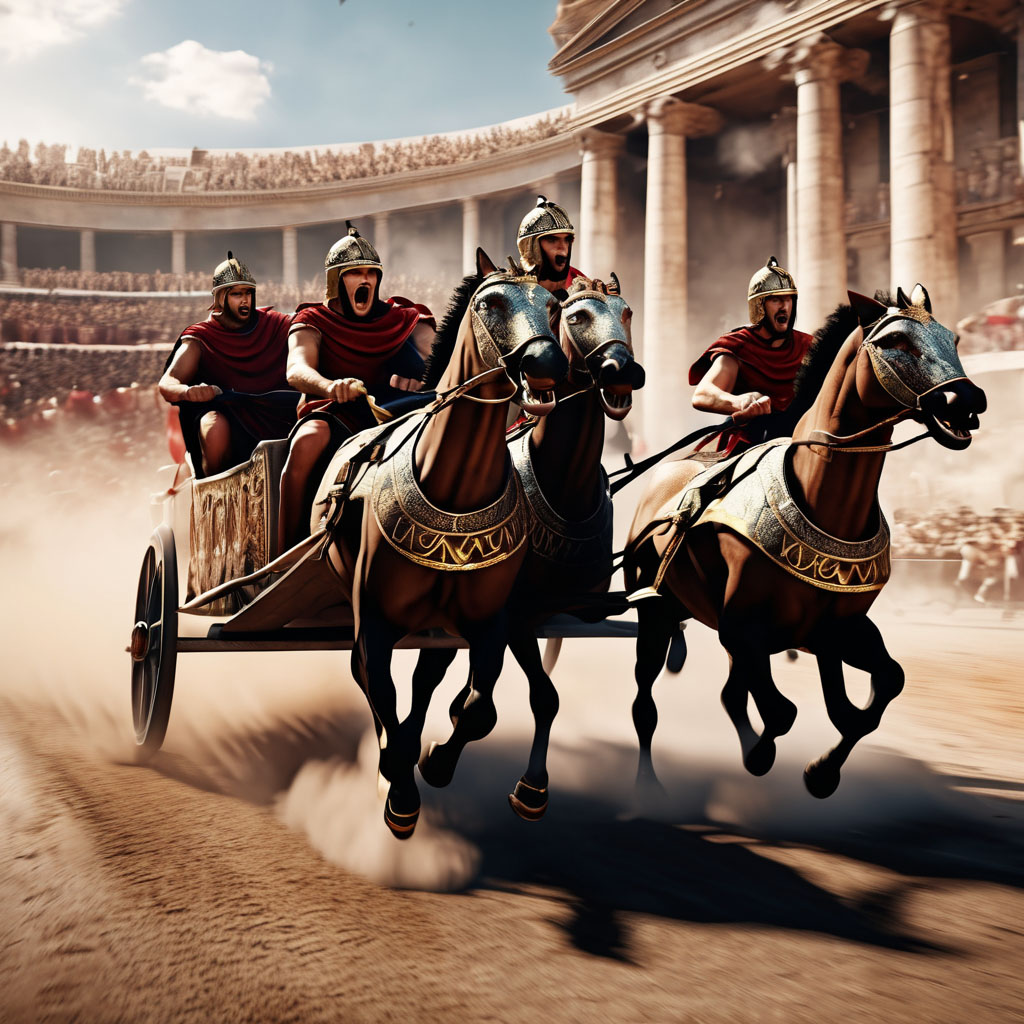 One reason for this neglect is the poor treatment of Byzantium by historians of western civilization. When Gibbon published The Decline and Fall of the Roman Empire in the late 1700’s, his uncomplimentary views of the Byzantine Empire had a strongly deterrent effect on Byzantine historical studies. He described the annals of the Eastern Empire as “a tedious and uniform tale of weakness and misery,” and concluded that Byzantium contributed nothing to the history, philosophy, or literature of the Roman civilization. This attitude of contempt was adopted and reinforced by later historians, and the writing of specific histories was delayed until the middle of the nineteenth century. Major works in the English language were produced at the end of that century, and Byzantine achievements became more deeply appreciated. The contributions of Byzantium to western civilization are now more widely recognized, and much of the mystery and misunderstanding in which that empire had been enshrouded has gradually been removed.
One reason for this neglect is the poor treatment of Byzantium by historians of western civilization. When Gibbon published The Decline and Fall of the Roman Empire in the late 1700’s, his uncomplimentary views of the Byzantine Empire had a strongly deterrent effect on Byzantine historical studies. He described the annals of the Eastern Empire as “a tedious and uniform tale of weakness and misery,” and concluded that Byzantium contributed nothing to the history, philosophy, or literature of the Roman civilization. This attitude of contempt was adopted and reinforced by later historians, and the writing of specific histories was delayed until the middle of the nineteenth century. Major works in the English language were produced at the end of that century, and Byzantine achievements became more deeply appreciated. The contributions of Byzantium to western civilization are now more widely recognized, and much of the mystery and misunderstanding in which that empire had been enshrouded has gradually been removed.
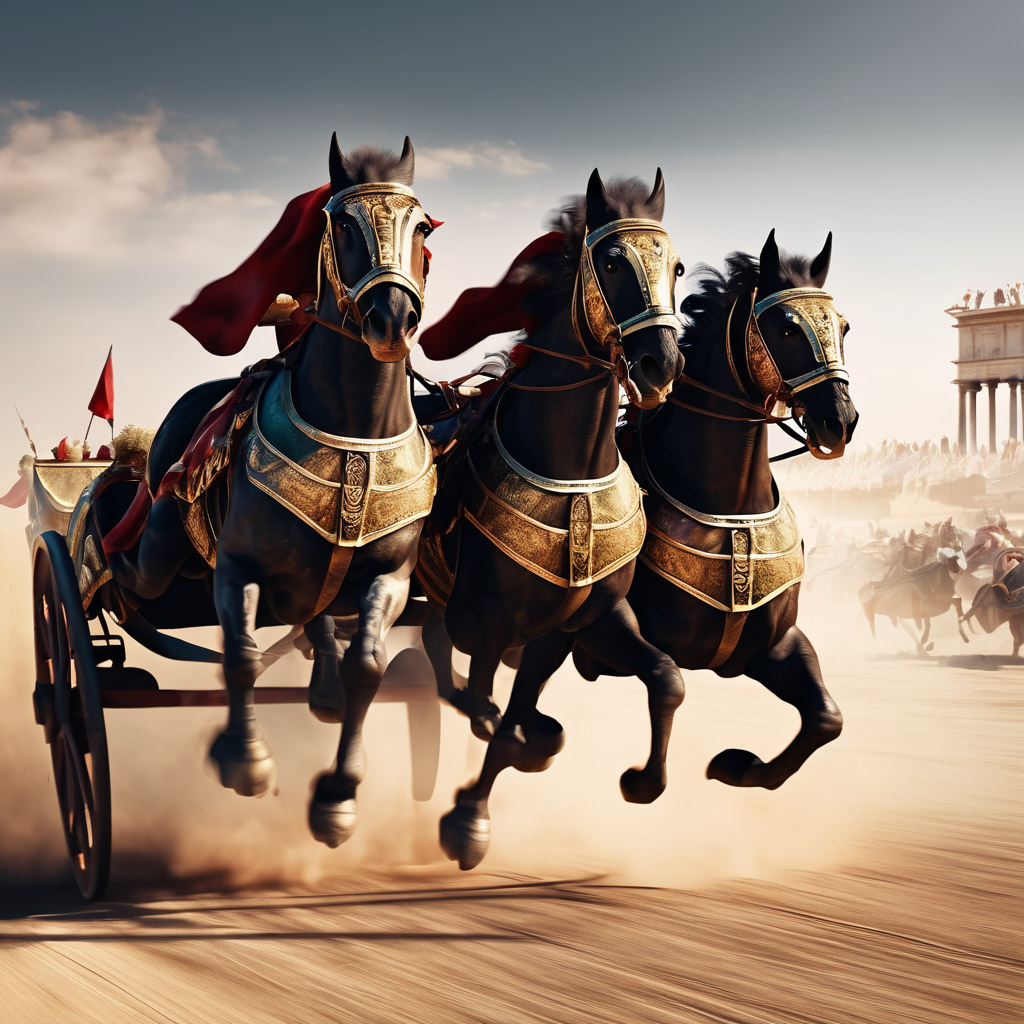 The history of Byzantium is far from complete, however. Unlike ancient Greece and Rome, for which the historian has ample evidence, significant portions of Byzantium’s records were destroyed in the very events that constituted its history: the iconoclast controversy, the rape of Constantinople during the Fourth Crusade, and the final conquest of the Empire by the Ottoman Turks. Also, the modern city of Istanbul is built upon a vast treasure-house of archeological evidence, only a fraction of which has been excavated, and documents, coins, and seals that have yet to be collected will no doubt add immeasurably to the social and economic history of Byzantium. In this manner, its history of sports and physical recreation will also be advanced.
The history of Byzantium is far from complete, however. Unlike ancient Greece and Rome, for which the historian has ample evidence, significant portions of Byzantium’s records were destroyed in the very events that constituted its history: the iconoclast controversy, the rape of Constantinople during the Fourth Crusade, and the final conquest of the Empire by the Ottoman Turks. Also, the modern city of Istanbul is built upon a vast treasure-house of archeological evidence, only a fraction of which has been excavated, and documents, coins, and seals that have yet to be collected will no doubt add immeasurably to the social and economic history of Byzantium. In this manner, its history of sports and physical recreation will also be advanced.
The information that is available to the sports historian is derived from the translations and interpretations of manuscripts, imperial codes and laws, and epigrams; and the examination of artifacts such as mosaics, paintings, textiles, diptychs, bas-reliefs, and stelai.
An important consideration in the historical research of Byzantine sport concerns the controversial nature of one of its oldest traditions, the importance of the circus factions — the Blues and Greens — in Constantinople. Until very recently, historians of the Byzantine Empire subscribed to the theory, proposed at the turn of this century, that the Byzantine circus factions were more than mere sporting associations; that they represented the political, religious, economic and social divisions of the population of Constantinople; and that they formed an urban militia that played an important role in the city’s history. However, with the 1976 publication of Cameron’s exhaustive and scholarly work, "Circus Factions: Blues and Greens at Rome and Byzantium,” that traditional view has been replaced by a new interpretation. Many of Cameron’s findings will be presented in this paper.
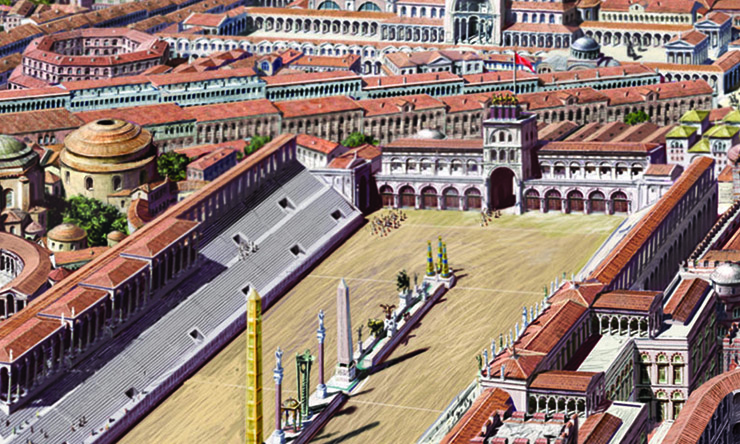 The people of Byzantium, and in particular those closely associated with the imperial court, enjoyed a variety of sport forms, either as participants or as spectators. Skill at horsemanship was a predominant feature of many of these activities, and its importance was derived from the oriental cultures that influenced the Empire, as well as from the heritage of Greece and Rome.
The people of Byzantium, and in particular those closely associated with the imperial court, enjoyed a variety of sport forms, either as participants or as spectators. Skill at horsemanship was a predominant feature of many of these activities, and its importance was derived from the oriental cultures that influenced the Empire, as well as from the heritage of Greece and Rome.
The most popular sport, and the one for which most information is available, was chariot racing. During the early years of the Empire, the Greek form was still practiced, as evidenced by the custom of awarding victory to the owner, rather than to the charioteer. However, by the fifth century, when the Golden Age of chariot racing had arrived, it was clearly the race of the Roman circus that was seen in the hippodrome of Constantinople. After its establishment as the most popular sport of all classes, chariot racing became ritualized as part of the ceremonies surrounding the imperial court, and maintained a pre-eminent position until its decline in the twelfth century.
Races were conducted in the same manner as those in Rome. Four quadrigae participated in each race, representing the four colours — Red, White, Blue, and Green. Charioteers drew their starting positions with balls placed in a revolving lot-casting urn, and then raced seven laps around the hippodrome.
Crowds filled the stands every race day, and the element of danger, excitement, and loyalty for a racing colour would have been familiar to any Roman of the Early Empire.
The number of races presented in one day varied over time. In sixth century Constantinople, the standard programme offered twenty-five races, but by the tenth century, this had been reduced to eight. In addition, Byzantine racing included a feature not recorded in other cultures. Known as the diversium, it provided an opportunity for the winner of a race in the morning to challenge the loser to a re-match in the afternoon, with horses and chariots exchanged. In this manner, the doubly-successful charioteer could demonstrate that his wins were the result of skill, rather than of luck. An epigram honouring the outstanding charioteer, Constantine, records that he won twenty-five races in the morning and twenty-one in the afternoon. This implies a racing programme of fifty races, but Cameron suggests that this may have been a special occasion, arranged to give this popular charioteer an opportunity to display Byzantine chariot races also incorporated a classification system that was probably Greek in origin. Three classes were established, according to the age of the charioteers: boys, under seventeen; youths, from seventeen to twenty; and men, over twenty. These classes were noted early in the sixth century.
During the mid-day interval of a typical racing programme, spectators remained in their seats and were entertained by a wide variety of performers. A series of individual acts or turns were presented: these included dancers, wild beasts, clowns, and on occasion, some of the spectators themselves. Mimes and singers performed, and acrobats walked a tightrope strung high above the circus floor. It is not certain how these activities evolved over the years, but they were recorded as an important and popular part of the festivities during the tenth century.
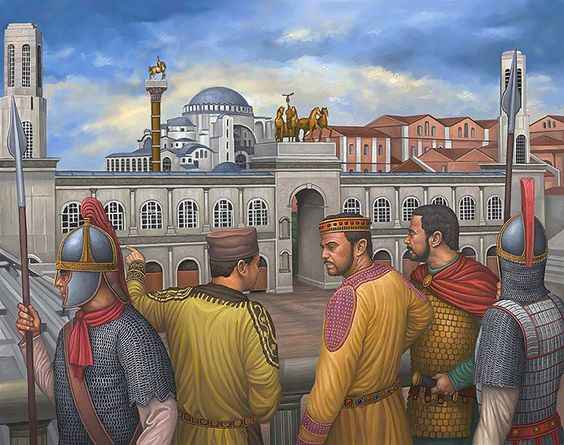 The hippodrome was one of the most important structures in Constantinople and a central feature in the life of its citizens. Originally built by Septimius Severus at the end of the second century A.D., it was enlarged by Constantinople after he inaugurated his new capital in 330. In the traditional Roman style, the spina, with dolphins and eggs as lap counters, was lavishly deco- rated by emperors, and featured works of art that were famous throughout the Empire. As described by Robert of Clari in 1204, the spina was high and narrow, standing about fifteen feet above the floor of the circus and extending down the centre of the track for approximately 230 yards. Byron states that the exotic objects on display included: an elephant with a trunk that moved; a gigantic statue of Hercules of Lysippus, measuring six feet from knee to foot; a bronze eagle with holes in its outstretched wings through which the sun shone to mark the hours on a dial; and a giant woman holding a life-size horse.
The hippodrome was one of the most important structures in Constantinople and a central feature in the life of its citizens. Originally built by Septimius Severus at the end of the second century A.D., it was enlarged by Constantinople after he inaugurated his new capital in 330. In the traditional Roman style, the spina, with dolphins and eggs as lap counters, was lavishly deco- rated by emperors, and featured works of art that were famous throughout the Empire. As described by Robert of Clari in 1204, the spina was high and narrow, standing about fifteen feet above the floor of the circus and extending down the centre of the track for approximately 230 yards. Byron states that the exotic objects on display included: an elephant with a trunk that moved; a gigantic statue of Hercules of Lysippus, measuring six feet from knee to foot; a bronze eagle with holes in its outstretched wings through which the sun shone to mark the hours on a dial; and a giant woman holding a life-size horse.
Only three objects from the imperial period are still standing on the present-day site of the spina; these are badly damaged and their original splendour can only be imagined. The best-preserved is the Egyptian porphyry obelisk from the Temple of Karnak, together with its base, commissioned by Theodosius the Great. The base, with each of its four sculpted sides depicting scenes from the hippodrome, provides important information about Byzantine chariot races and the activities of the imperial family in the circus.
Histories and chronicles have survived with descriptions of the structure of the hippodrome at the peak of its glory, and although the descriptions conflict in some details, it is generally accepted that the circus was 1200 to 1300 feet long, and 600 to 650 feet wide. The track oval was 1000 feet in circumference, and was enclosed by tiers of spectator seats that rose 40 feet from the ground. Estimates of spectator seating range from 40,000 to 80,000 with 60,000 the most accepted figure. Bury stated that “it is not unlikely that the area occupied by the seats was larger in the Hippodrome than in the Circus Maximus.” The track was separated from the tiers by the euripus, or water-course ditch; at the southern end, the semicircular sphendone was suspended on massive vaults because the ground was not level at that point; and at the northern end, the carceres were surmounted by the famous piece of bronze sculpture, the ‘‘Four Horses,’’ which was taken from the hippodrome by the Crusaders in 1204 and now adorns the facade of the Basilica of St. Mark in Venice.
The above description indicates that the physical features of the hippodrome in Constantinople were similar to those of the Circus Maximus in Rome, and this is to be expected, given that the races themselves were conducted in the same manner in both circuses. There were some interesting differences, how- ever, one of which has been proposed by Cameron in his examination of evidence related to the spina in Constantinople. He concludes that the spina was protected by four metae or turning-posts, rather than the two posts associated with other circuses. This conclusion is based on description of statues that were “close to the turning-post of the Reds, that is . . . the Eastern turning-post.” Since it is known that the north and south posts were assigned to the Blues and Greens respectively, symmetry and the existence of four colour factions suggests a fourth, western post of the Whites. Two purposes of this arrangement are advanced: if the spina was a long rectangle, the Red and White metae could have given advance warning to the charioteers of the main metae ahead; or, the spina may have been somewhat cruciform in shape, with the Red and White metae thus serving to protect the side extensions of the spina.
Another difference at Constantinople was the inclusion, in the Eastern grand-stand, of the kathisma — the imperial box — in which the Emperor, his family, and important members of the imperial household sat to watch the races. The kathisma was directly linked by a spiral staircase and internal passageway to the Sacred Imperial Palace, adjacent to the hippodrome. The front of the box was an open balcony that looked down on the track, but from the hall immediately behind this balcony, the kathisma could be sealed off from both the hippodrome and the palace. This arrangement gives some indication of the important role that the Emperor played in the activities of the circus. The kathisma had its origins in the pulvinar, or royal enclosure, which Augustus had built for himself, his family, and his guests in the Circus Maximus in Rome.
Special sections of the grandstands were set aside for each of the colour factions, on the west side of the hippodrome, that is, the side facing the kathisma. Cameron places them in the following order: Blue nearest to the carceres, then White, Red, and finally Green nearest to the sphendone. With the traditional rivalry that existed between the factions, this juxtaposition frequently contributed to fights in the grandstands. Of greater importance, however, was the general placement of the colours across from the Emperor’s box, a position that allowed the factions to perform their unique role in the imperial ceremonies associated with the races.
Also located in the hippodrome were the silver bellows-type organs of the Blues and Greens. There is evidence of an organ associated with the races in the fifth century, and by the tenth century, both organs were utilized in the imperial liturgy. It is also probable that these instruments accompanied the partisan dancers who performed in the interlude between races, and were used in the acclamation of chariot race victories.
Chariot races were the most important events in the life of the ordinary Byzantine citizen, and race days were occasions for excessive gambling, roistering, eating, and shouting — providing a particular kind of excitement and entertainment not available to him in any other facet of his life. The spectator chose a circus colour, and supported it for the sake of the supporting; “and he shoved, screamed and lost his temper for the pleasure of it, for the intoxication of taking sides. As a colour partisan, the Byzantine gambled his self-esteem on the outcome of the race, and this enthusiastic backing of a racing colour gave him an opportunity for contest, rivalry, and risk that was otherwise denied him in an increasingly authoritarian society.
Attendance was apparently restricted to men. Cameron noted that the kathisma was surmounted by a room with grilled windows, from behind which the ladies of the court could watch the events below, “it not being considered proper for ladies to attend the games in the ordinary way.” In a reference to factional rivalry, Procopius commented that women joined factions, although they never even went to the games. Byzantine women appear, then, to have lost some of the social freedom that Roman women had enjoyed.
Because the hippodrome was the most important gathering-place for large numbers of spectators, other events that required a large audience were also staged there. The most significant of these was held in connection with the accession of a new emperor, whose inauguration was not complete until he had been ceremoniously acclaimed by the people of Constantinople assembled in the hippodrome. If the triumph of a victorious emperor or general was to be celebrated at the time of a race-meeting, these ceremonies also took place in the hippodrome. Less pleasant, but no less popular, were the public punishments and executions held in the circus; here, some emperors were even executed by their successors, and certain criminals were beheaded or branded before large crowds gathered to witness this spectacle.
Byzantine history is liberally sprinkled with accounts of riots, acts of vandalism, and violent demonstrations, many of which occurred in the hippodrome, and often involving one or more of the colour factions. Records refer to fights between these colour partisans that escalated from simple faction rivalry into full-scale rioting. The most serious riot in the hippodrome was the infamous Nika Revolt of 532, which began as a typical faction riot, developed into a major disturbance, and finally ended with the ruthless slaughter of 30,000 people trapped in the hippodrome.
In stark contrast to these events, several principal church festivals were also celebrated in the hippodrome. The “Hippodrome of Meat,” the Byzantine equivalent of Mardi Gras, marked the last day before Lent on which meat could be eaten. As a replacement of the pagan Lupercalia, it also heralded the beginning of spring, and was the occasion for ceremonial chariot races, choral singing, and dancing. The most important national festival of the year was the Genethliaca, celebrating the anniversary of the founding of Constantinople. The races held to commemorate this event were known as the “Hippodrome of Vegetables.” Both the emperor and, the patriarch of Constantinople attended these festivities, and presided over the distribution of vegetables, bread, fish, and cakes to the poor, a variation of the early Roman practice of dispensing annona civica, or “political bread.” The “Hippodrome of Vegetables” was part of a general and increasing custom of Christian charity which put Byzantine “social services . . . far in advance of anything to be found elsewhere in Europe.”
Although ceremonies with a religious component were conducted in the hippodrome, the Christian Church was a reluctant participant in these rituals. Church leaders held strong moral objections to the secular amusements that had been inherited from pagan Rome, and would have been pleased to see them disappear completely from Byzantine life. But chariot racing was too important to the citizens of Byzantium, and the church therefore used its victory over paganism to modify the ancient hippodrome ceremonial and give it Christian connotations. Cameron stated that:
One of the main purposes of the religious side of hippodrome ceremonial was to serve as an incentive to religious solidarity; to create and foster the all important theme of an emperor appointed by God as the protector of the faithful and champion of orthodoxy.
Races in Constantinople were opened with the emperor making the sign of the Cross, while the crowd hailed him as God’s representative and the factions sang hymns. Following the races, victorious charioteers gave thanks at the nearest church.
The unique association of the emperor with the races was one of the most important features of Byzantine sport. Because the emperor was believed to be “the chosen instrument of God, a man selected by Providence to become the divine representative of earth,” everything associated with him became a part of the imperial liturgy, and ritualized religious ceremonies governed every aspect of his public life. A fundamental feature of the imperial cult was the significance of victory. Victory of any kind, anywhere in the Empire, was associated with the emperor and became his victory; conversely, all victories emanated from the emperor, as the earthly representative of God. By the sixth century, the victory cult of the emperor had become firmly established as part of the ritual of the hippodrome; victories in chariot races were linked with the emperor, and this connection was reflected in the imperial ceremony of the circus. When a winning charioteer moved forward to receive his prizes from the emperor after the race, the charioteer’s supporting faction would chant to the emperor: “We ask for equal share of your victory that comes from God, an equal share of your victory, Master, the faith of the kings prevails.” Thus, the charioteer’s victory is seen as but a victory of the emperor.
With this hippodrome ritual, the emperor’s image and sovereignty were rein- forced, and at the same time, the people were able to acclaim their leader. They were also able, on occasion, to make their concerns and wishes known to him and his advisers, a custom inherited from Rome.
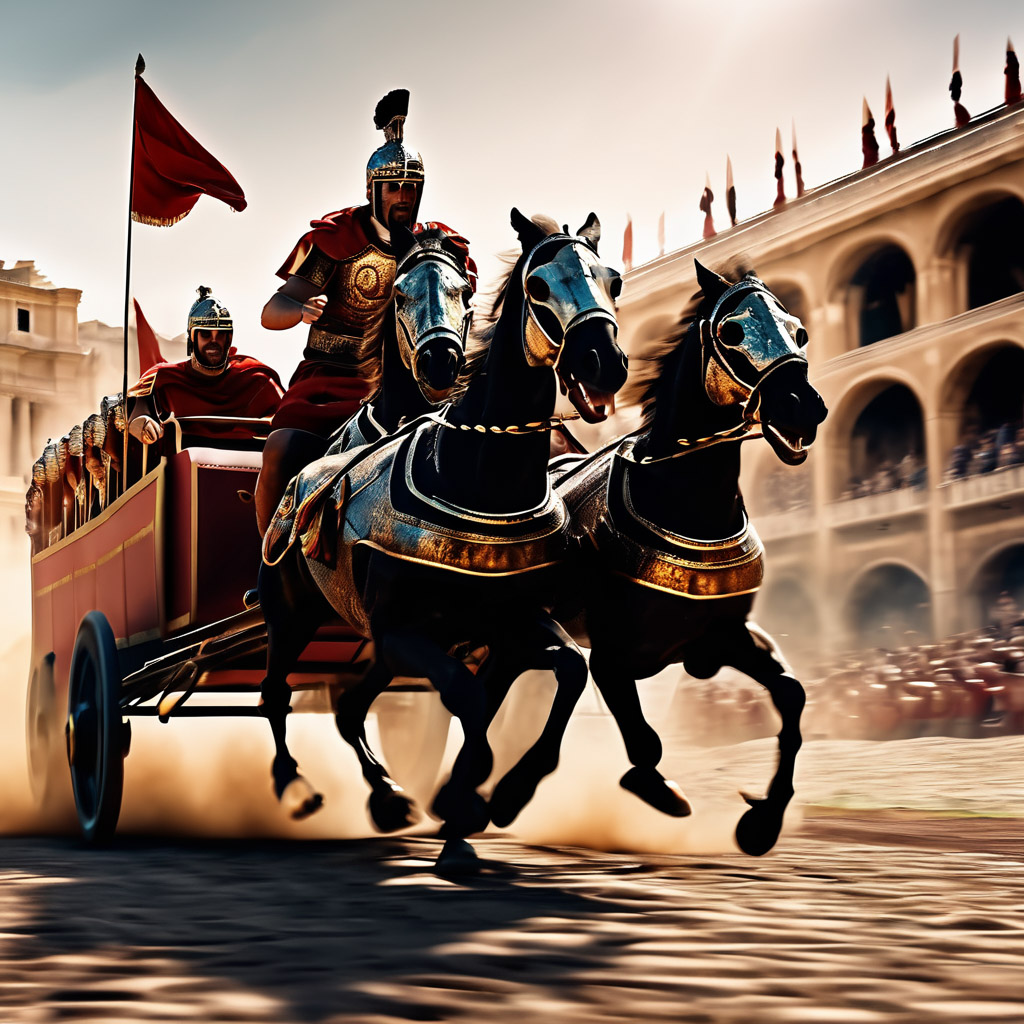 By the sixth century, the hippodrome had acquired a political and religious significance never attached to the Roman circus, and for this reason the spina in Constantinople has been described as “the axis of the Byzantine world.” In time, however, this importance declined, and by the tenth century, public protests and official ceremonies had moved to the great square in front of the Palace. In the mid-eleventh century, the emperors took up residence in the Blachemae Palace on the outskirts of the city. This eroded the importance of the hippodrome even further; then, when it was blackened by fire in 1203 and despoiled by the Crusaders one year later, it fell into partial disuse. Although occasional jousting events, polo games, and displays of wild beasts were presented there, by the time Constantinople fell to the Turks in 1453, the hippodrome had long since ceased to be the centre of life in the capital city.
By the sixth century, the hippodrome had acquired a political and religious significance never attached to the Roman circus, and for this reason the spina in Constantinople has been described as “the axis of the Byzantine world.” In time, however, this importance declined, and by the tenth century, public protests and official ceremonies had moved to the great square in front of the Palace. In the mid-eleventh century, the emperors took up residence in the Blachemae Palace on the outskirts of the city. This eroded the importance of the hippodrome even further; then, when it was blackened by fire in 1203 and despoiled by the Crusaders one year later, it fell into partial disuse. Although occasional jousting events, polo games, and displays of wild beasts were presented there, by the time Constantinople fell to the Turks in 1453, the hippodrome had long since ceased to be the centre of life in the capital city.
The circus factions of Byzantium were important elements in the conduct of chariot races, and differed in a number of significant ways from the racing companies of Rome. By the beginning of the sixth century, the eastern fac- tions were simply four groups of performers and partisans, administered and financed within a single guild of public entertainers. These groups were assigned the time-honoured colour — Blue, Green, Red, and White — that had been associated with chariot racing since the days of the Roman Republic, but they were not independent enterprises as those earlier companies had been. Instead, the Byzantine factions were state-controlled and state-financed groups of performers and fans — in effect, nationalized institutions. Contrary to the traditional view presented by most modern Byzantine historians, the circus factions of the Eastern Empire were not political parties, had no specific religious orientations, did not divide the population along class lines, and represented no particular geographic sections of the capital city. Rather, they consisted primarily of fans of the circus, theatre, and arena, whose boisterousness and hooliganism often resulted in partisan riots associated with these public entertainments. When the imperial state absorbed the factions into the administrative structure of Byzantine public life, they became a recognized and integral part of the imperial liturgy of the Empire, and thus received sanction and support from the emperor and, with some reservations, from the Christian Church.
The evolution of this phenomenon had its roots in the final period of Hellenistic sport and entertainment. In the middle of the fourth century, the Greek gymnasium disappeared, probably because of financial starvation, Christian anti-pagan pressures, and fundamental changes in public taste and attitudes.
Other forms of entertainment continued to flourish, including the pantomime theatre, gladitorial games, venationes, and wild-beast shows; and Greek-style chariot racing was still included in the athletic festivals conducted in the east- em provinces. But by the end of the fifth century, gladiatorial games and venationes had been permanently abolished, and pantomime dancing had fallen under one of its frequent bans. Into this social void in the entertainment life of the inhabitants of Byzantine moved the sport of Roman chariot racing, hereto- fore popular only in Alexandria and Constantinople—the former a city with a strong Roman tradition, and the latter the site of a hippodrome built as an adjunct of an imperial residence. Long supported by emperors and consuls, chariot racing soon became the favourite pastime throughout the Byzantine Empire, and during the sixth century, it reached its peak of popularity and importance.
This change of sporting preferences was accompanied by other important developments, which took place in the fifth century. One of these changes was associated with pantomime dancing, a Greek innovation that was particularly popular throughout the fifth century. As early as the first century A.D., the top performers commanded large followings, and dancers hired small bands of partisans as claqueurs to produce orchestrated applause and thus ensure adequate audience appreciation. The rowdy behaviour associated with pantomime dancing audiences often sparked riots, with the result that shows were frequently banned by the authorities and condemned by the Church. In time, the theatre claqueurs began to apply their skills to political demonstrations in the provincial cities, and the resulting disruptions finally forced the authorities to bring them under imperial control. This was done by effecting an amalgamation of theatre partisans with the performers and fans of chariot racing. The product of this amalgamation was a single four-part guild of public entertainers with an administrative hierarchy appointed by imperial authorities, and with each part assigned one of the traditional circus colours. Now, races were organized by the professionals of the hippodrome, that is, the members of the guild, and all expenses were paid with public funds. In this manner, the sport of chariot racing became dependent upon imperial financing and administration. By the sixth century, the other public entertainments of pantomime dancing and wild-beast shows were also controlled through this guild, and along with chariot racing, were answerable to imperial headquarters. Prior to the amalgamation, spectators in the hippodrome had not been particularly disorderly, but after their union with pantomime fans, the rowdy element of the theatre was transferred to the circus, resulting in the riots and demonstrations that gave the Blues and Greens such an unsavoury reputation in the eyes of later historians. The expertise of the theatre claqueurs, or “cheer-leaders,” was adroitly employed in the acclamations of the emperor, and the large crowds assembled in the hippodrome were led by the 35 factions leaders, or demarchs, in ritual tribute to the emperor.
It is probable that this amalgamation, and the unique organization of the Byzantine factions, occurred during the reign of Anastasius (491 to 518). Before his accession, there was little reference to Blues and Greens in the East; but towards the end of his reign, the colour factions became prominent in the circus, and demonstrations and riots were associated with all facets of public entertainment. This period coincided with the increase in importance of the emperor as an absolute monarch of near-divine status, and with the inclusion of imperial acclamations in the ceremonies of the hippodrome. The numbers of Blues and Greens increased significantly, following amalgamation, for there had originally been far more theatre partisans than circus fans. In the final stages of this evolution, the Blues and Greens, as the principal factions, were associated solely with imperial ceremonies, both inside and outside the hippodrome.
During the later empire period, the political importance of the Blues and Greens was derived primarily from their role in the ritual acclamations of the emperor, and not as the voice of opposition to authority. With their institutionalization as part of the state administration, the factions effectively forfeited the ancient tradition of parrhesia, or collective freedom of speech, that had been a part of their Greek and Roman heritage. This is not to say that there were no demonstrations, or that emperors no longer heeded pro- tests when the people of Constantinople assembled in the hippodrome to voice their frustrations in a tightly-controlled and centralized society. But rarely were the circus factions actually responsible for these protests, and factional riots were usually the result of strong rivalry arising from the chariot races as mere sporting events.
Factional riots associated with the races probably decreased to an insignificant level in the seventh century, after the factions had become an established part of the imperial court. They rioted less, if at all, because, as part of the official life of the court, they were now above that kind of behaviour. Thus, while the records give the impression of a decline in the importance of factions, in fact, because the Blues and Greens dominate all accounts of factional activity, it is often assumed that the Reds and Whites disappeared at an early stage in the history of the Byzantine Empire. There is sufficient evidence, however, to show that all four colour parties were included in the imperial ceremonies until at least the tenth century. The colours were paired — usually Red with Green and White with Blue — and these two groups of pairs formed the basic rivalry organized and presented by the guild of public entertainers. We are thus presented with another example of the dualistic nature of ritual sport found in so many early civilizations.
The factions were responsible for the ceremonial performances associated with public appearances by the emperor. Their ritual duties consisted of prescribed acclamations, applause, chants, and hymns, and were strongly influenced by Christian liturgy and purpose. Details of the faction duties were described in the Book of Ceremonies, written in the tenth century by Constantine VII Porphyrogenitus, and this document indicates that these functions were performed as early as the sixth century.
The principal political influence of the Blues and Greens stemmed from their duties at imperial coronations. Not until he had been properly proclaimed by the people in the hippodrome, under the leadership of the Blues and Greens, could a new emperor be installed in office. On occasion, formal proclamation was withheld by the factions for political reasons, but this only occurred at times of serious conflict, and the final resolution of such conflict was actually effected by the leaders of the state, rather than by the circus partisans themselves. Therefore, although the factions had the power to withhold approval of a new emperor, in practice this power was seldom used.
Although chariot racing was the most important sport in Byzantium, and dominates all accounts of sports and amusements in the Eastern Empire, its position of pre-eminence was not reached until the sixth century. Prior to that time, the most popular spectator sports were those of the Roman arena - gladiatorial fights, venationes, and exhibitions of wild beasts. In Constantinople, these events were presented in the arena known as the Cynegion. The last after that time, such entertainments were probably performed in the hippodrome, either in the intervals between chariot races or as separate programmes.
By the early sixth century, however, these sport forms were no longer being presented. Gladiatorial fights were the first of these activities to disappear; changing tastes, imperial disfavour, and the expense and difficulty of providing gladiators were factors in the demise of this once-popular sport. The last such event in Rome is believed to have taken place in 439 or 440, while in the east, gladiator fights ceased late in the fourth century. Venationes, or fights between men and beasts, lasted longer; Anastasius banned them in the east in 498, and the last recorded presentation in Rome was 523.
However, exhibitions of wild beasts continued to be presented in the Eastern Empire, and an examination of consular diptychs of the period reveals that the particular form of venatio performed in Constantinople during the first decades of the sixth century differed from that seen in the Western Empire at an earlier time.
Consular diptychs were ivory carvings on two hinged panels, sculpted to commemorate the accession of a consul to office, and were presented as complimentary gifts from the new consul to important personages. A large number were executed for each consul, and many diptychs depicted the consul presiding over public entertainments at the theatre, the circus, or the arena. The lower portion of each panel was filled with figures and scenes from the corresponding entertainment, and these scenes give some insight into the Byzantine style of venatio.
It is apparent, from a study of these diptychs, that the brutality and bloodshed so common in Roman venationes were not features of the Byzantine version. Gone were the heavy armour and shields of the western venator, to be replaced by a variety of devices designed to protect the combatants, both human and animal; and designed, also, to provide lighthearted entertainment for the audience. These scenes suggest the tricks and turns of a modern circus act rather than the deadly combat of the Colosseum.
One leaf of the Areobindus diptych of 506 illustrates methods by which the venator could avoid contact with the animals. Doors at the sides of the arena are held open by attendants in case the unarmed performer or acrobat needs to make a hasty exit. A narrow platform, consisting of two uprights and two crossbars lets the acrobat climb out of reach of the animals. One performer is protected by a high, slatted, mobile barrier or shield. Another performer leaps over an approaching animal with the aid of a vaulting pole, identified by Jennison as the ‘‘Contobolon.” Finally, two men sit in baskets attached to an upright pole and move up and down away from the animals, in see-saw fashion, with the aid of a rope strung over the top of the pole. Another diptych also depicts the see-saw baskets and vaulting pole; the open doors at each side are obviously intended as avenues of escape, with one performer shown moving toward the door, while the attendant inside is poised to close it quickly with a rope handle. It is evident that this form of entertainment was not without hazard, for one performer is being bitten in the leg, in spite of his ropes to restrain the animals.
An unusual device is sculpted into a third diptych. enough to contain a man, and constructed with openings through which he can reach with his hand to tease the animals. Jennison labelled this the “Canisterum’’ and in describing its effect, stated that:
The infuriated animal falls upon it, bowls it fast and far over the arena, amid the laughter of the spectators—redoubled when the uncanny case rolls slowly and steadily back again to attack the baffled enemy. Danger is not eliminated, a leg or arm may fall to teeth or claws, but the risk of death has almost gone.
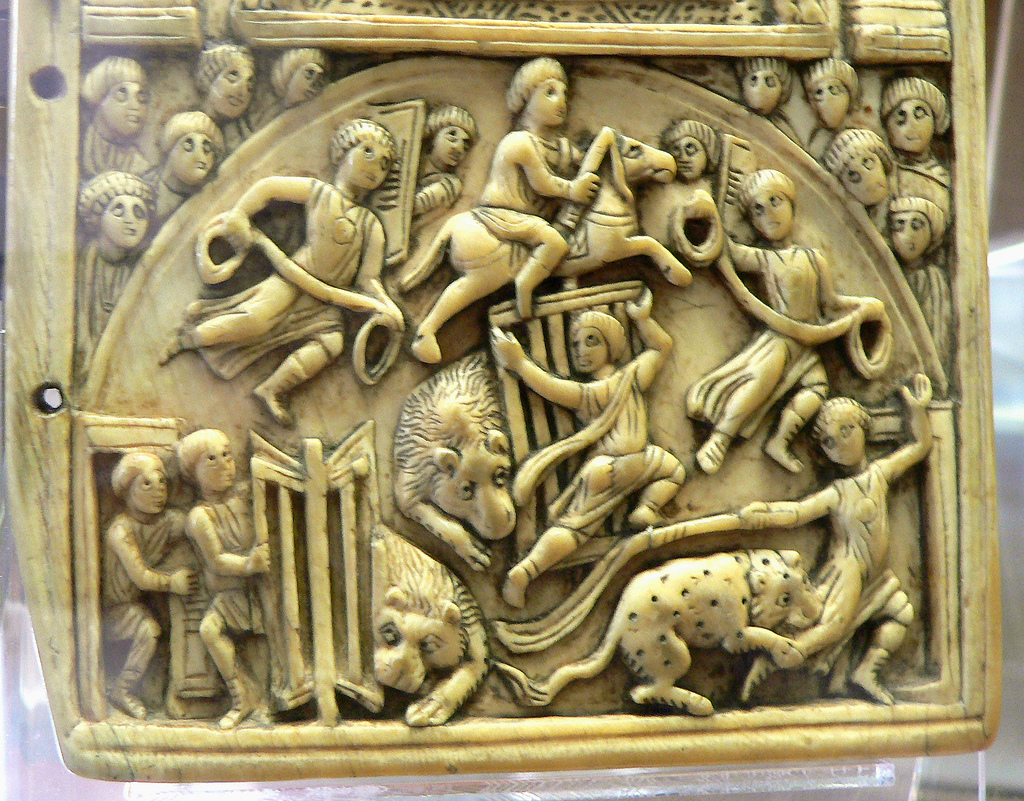
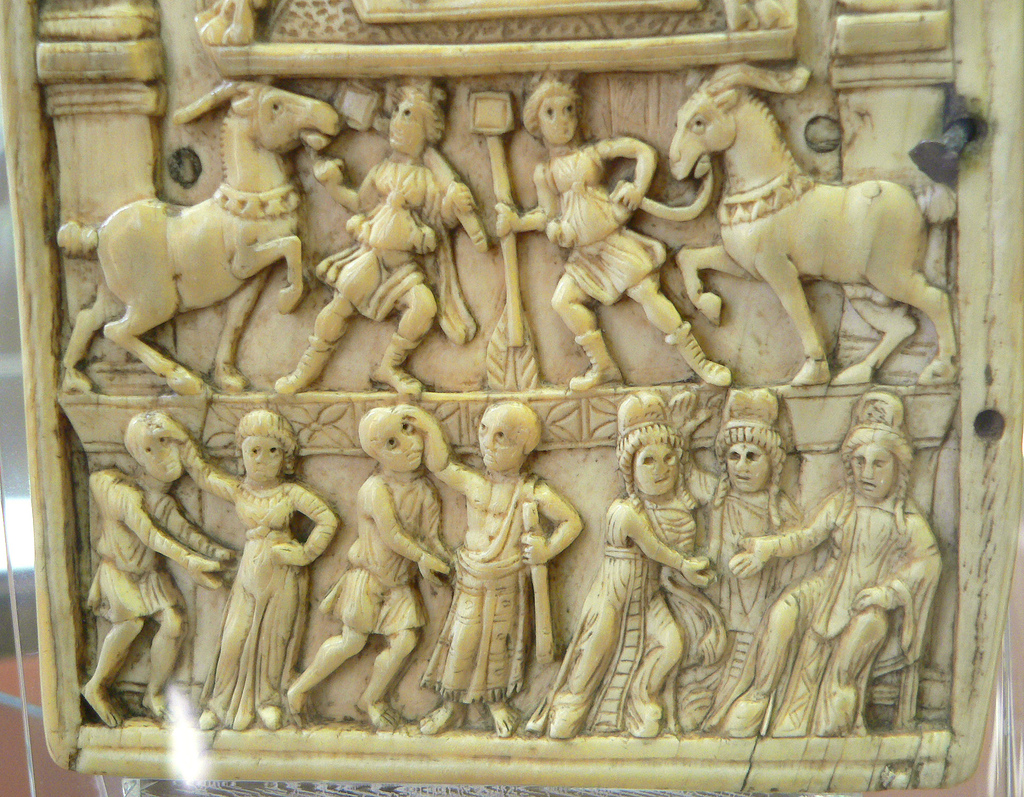 On the diptych of Anastasius of 517 (a grand-nephew of the emperor), one can see further representations of the slatted barriers, as well as whips and ropes to restrain the animals. It is evident that this form of entertainment was not without its hazard for one performer is being bitten in the leg in spite of his flailing whip!
On the diptych of Anastasius of 517 (a grand-nephew of the emperor), one can see further representations of the slatted barriers, as well as whips and ropes to restrain the animals. It is evident that this form of entertainment was not without its hazard for one performer is being bitten in the leg in spite of his flailing whip!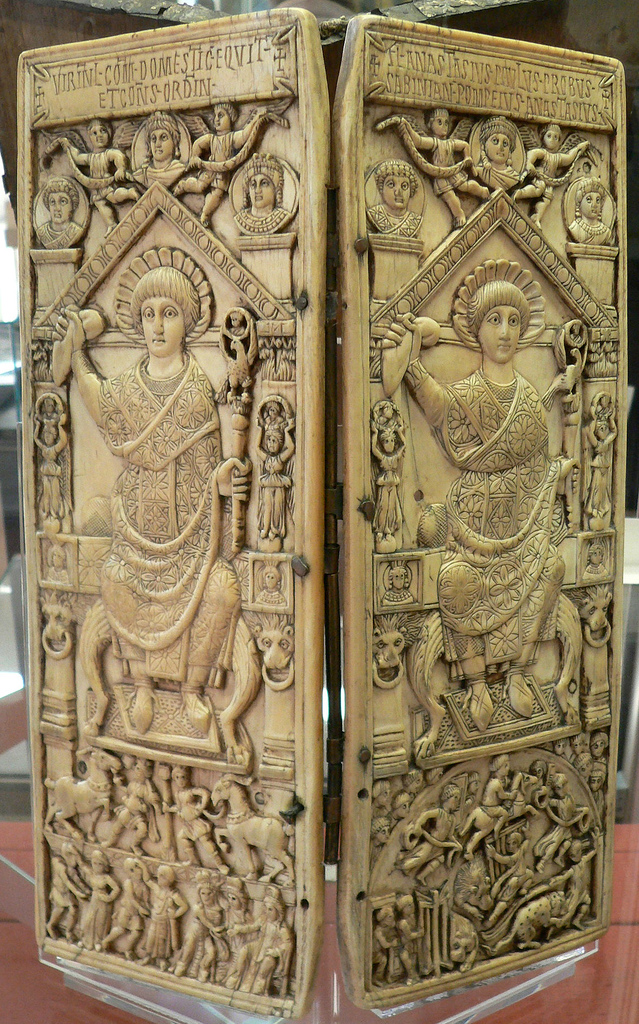
Not all wild beast exhibitions were bloodless, however, for a diptych of 507 contains a scene similar to the traditional Roman style of venatio. Four venatores are seen battling lions with spears, and all have succeeded in impaling their animals in decisive fashion. The left shoulders and upper arms of the venatores are covered with a form of protection, and each venator is stationed close to a door, ready to exit quickly if necessary.
These wild-beast fights and exhibitions were common and popular in the Byzantine Empire until the beginning of the sixth century, and by then, most were lacking the ferocity and danger of their western antecedents. Jennison stated that “the Christian religion, though it could not kill the shows, yet managed to soften them considerably.” Chastagnol described the events as ‘‘des jeux édulcorés, simples exhibitions de bêtes, avec simulacres de combats et exercices d’adresse ou d’acrobatie”; that is, sweetened or softened games and sham fights with an emphasis on adroitness and skill.
The enormous expense of providing wild animals, as well as the increasing difficulty in obtaining them, were important factors in the eventual disappearance of this form of entertainment. Thus, by the time chariot racing had reached its peak of popularity, wild-beast fights in the Byzantine Empire had ceased to exist.
Not all sports of Byzantium were inherited from Greece or Rome. Persia gave the world polo, and in due course, this horseman’s team game made its way to Constantinople, where it became a popular activity of the nobility. The introduction of polo to the Byzantine Empire is generally attributed by historians to Theodosius II, who reigned from 408 to 450. The game was known there as tyzkanion, presumably a variation of the Persian name, tschougan. The field on which Byzantine polo was played was called the tyzkanisterion, and Basil I (867 to 886), a devotee of the game, caused such a ground, measuring about seventy yards, to be built within the walls of the Imperial Palace.
Polo appears only as a game of the nobility, in the Byzantine Empire, and it can be assumed that this sport, like chariot racing, was incorporated into the imperial ceremony; participation by emperors was frequently reported, and since all imperial activities in the later periods were bound in ritual, polo would also have been granted this treatment.
Of particular interest is the form that polo took in Byzantium. According to the most detailed description available, the game resembled nothing so much as lacrosse-on-horseback. The historian, John Kinnamos, secretary to Manuel I Comnenus (1143 to 1180), described a game of polo, played in the winter of 1166-67 by his master, as follows:
Some youths who divide themselves equally cast a ball made of leather, comparable to the size of an apple, into some level space which seems right to them when they measure it out. As it lies in the middle like a prize, they charge their horses at full speed toward it, against one another. Each holds in his right hand a stick sufficiently lengthy, but which abruptly terminates in a broad loop which is divided in the middle with cords of gut, dried by time, intertwined with one another in the fashion of a net. Each side makes great haste to sweep it up and get it first to the other end, which from the outset has been assigned to them. Whenever the ball, driven by the sticks, comes to either end, this constitutes victory for that side. Such is this sport, very perilous and dangerous. It is constantly necessary that one participating in it turn backwards and swing his hips, spin the horse in a circle and engage in every sort of race and be carried along in as many types of movement as the ball happens to make.
Clearly, the netted loop at the end of the stick and the skill of sweeping the ball up imply a game in which the ball was gathered or caught, and then thrown with the stick, in contrast with the striking actions employed in the mallet version.
It is also reported that the French Crusaders, who passed through Byzantium in the twelfth and thirteenth centuries, became interested in the sport of polo as played in Constantinople, and introduced it into France, changing its name from tyzkanion to chicane. Diem stated that wherever polo spread, it appears also to have been played on foot.
It is quite possible, then, that a ball-and-stick game, similar to lacrosse, developed in France as a modification of tyzkanion. Henderson suggested this possibility, when he observed that chicane was associated with la soule, and that la soule was a fore-runner of modem lacrosse. Although opposition to this suggestion has been advanced, such a relationship certainly could have existed, following the introduction of Byzantine polo to the west.
In general, other sports and recreational activities in Byzantium differed very little from their counterparts elsewhere. The baths of Rome, for instance, were found throughout the Byzantine Empire, and fulfilled similar social and recreational functions. Byron noted that “the Turkish bath is in reality a direct offspring of the Roman through the Byzantine,” and that by 430, Constantinople boasted 8 public and 153 private baths.
Hunting, traditionally an aristocratic activity, was enthusiastically supported by Byzantine emperors, and the Byzantine hunter was offered an exciting and challenging selection of wild animals: lions, gazelles, leopards, antelopes, hippopotami, foxes, stags, bears, and hares.
A late development in aristocratic sport was the introduction of the western-style chivalric tournament. During the middle of the twelfth century, jousts were staged in the hippodrome, and after the Latin conquest in 1204, tourneys were also held in Greece and elsewhere in the Empire.
Although the activities described thus far were urban or aristocratic, country dwellers also participated in a variety of recreations. The chief occasions for these activities were market fairs or church festivals, with opportunities to engage in archery, dancing, wrestling, running, and single-stick fencing. In spite of church disapproval of such amusements, the state recognized their social value, and supported them. Country inhabitants were also entertained from time to time by travelling illusionists, acrobats, and tight-rope walkers; and in this manner, performances usually staged only in the cities and towns were made available to those living in the country.
Any examination of sport in the Byzantine Empire would be incomplete without reference to the termination of the Olympic Games, for it was within the territorial and temporal limits of this empire that the most important of all ancient Greek athletic festivals came to an end. It is widely held that the last celebration of the Games was in the year 393, purportedly the result of an edict of Theodosius the Great (379 to 395). However, some historians of ancient sport have questioned this date. Howell and Howell studied sources referring to the end of the Olympic Games, and examined The Theodosian Code, a compilation of imperial decrees to A.D. 438. They stated that “there is simply no decree abolishing the Games at Olympia by Theodosius,” and that “the evidence is not sufficient to place the end of the Games at Olympia at 393 or 394 A.D.” Nor did Robinson feel that the date of 393 was the only possibility. She cited two sources: the historian, Cedrenus, who placed the cessation of the Games in the reign of Theodosius the Great; and a scholiast of Drees supported A.D. 425 as the final date, basing his conclusions on a fire that destroyed the temple at Olympia in 426. Finally, it should be noted that Cedrenus, the twelfth-century historian from whose work the date 393 has been derived, was himself writing from the works of earlier historians, and thus has no independent authority. Therefore, it may be that his date has been given general acceptance only through repetition of an assumption drawn from the anti-pagan decrees of Theodosius the Great.
The case for a later date is just as strong as that for 393. During the reign of Theodosius II, edicts against pagan practices were repeated many times, and were strengthened by the decree that all pagan temples and shrines were to be destroyed; such edicts were proclaimed in 408 and again in 435. Therefore, one could also suggest that the last Olympic Games were in 405; or perhaps 433, after which the shrine to Zeus no longer stood as the symbol of religious sanction.
Theodosius the Great was not, apparently, opposed to the conduct of traditional activities in the vicinity of pagan temples, for in 399 he decreed that:
Lucian, who put the closing years in the reign of Theodosius II(408 to 450). destroyed; such edicts were proclaimed in 408 and again in 435.
Just as We have already abolished profane rites by a salutary law, so We do not allow the festival assemblies of citizens and the common pleasure of all to be abolished. Hence We decree that, according to ancient custom, amusements shall be furnished to the people, but without any sacrifice or any accursed superstition, and they shall be allowed to attend festal banquest, whenever 68 public desires so demand. [ 16.10.17]
Within these restrictions, then, the Olympic Games could have continued, but with the sacrifices long associated with the festival.
Also, athletic festivals per se were not eliminated at this time. It appears that meets were held well into the sixth century, for the Justinian code of 528 still carried a regulation that exempted from civil obligations those athletes who had won at least three wreaths at a sacred festival. According to Bury, The Theodosian Code suggested that the games were still being staged at Delphi during the reign of Theososius II (408 to 450). The stigma of pagan origin was obviously not enough to eradicate these activities; venationes, also derived from ancient pagan rituals, flourished for fully one hundred years after Theodosius the Great banned pagan sacrifice. And open paganism, in the form of pagan ideas, was condoned until 529, when Justinian closed the schools in Athens.
Given the meagre evidence for 393 as the final staging of the Olympic Games, and the continuation of similar activities for a number of years after that date, it is, perhaps, easier to believe that the Games simply came to an end gradually. Robinson suggested this, citing barbarian invasions, economic decline, or disastrous natural events as the likely causes for their cessation, while Cameron inferred that changing tastes and the disappearance of the gymnasium were the principal contributing factors. Clearly, the question is still unresolved and evidence that would produce a conclusive answer has either been destroyed or has yet to be discovered.
In conclusion, any attempt to generalize about Byzantium presents certain difficulties, because this complex civilization, which spanned eleven centuries, included within its boundaries, at various times, most of the civilized Mediterranean world, Asia Minor, and that part of Europe now known as the Balkans. However, there are a number of characteristics that the Byzantine Empire did retain throughout its history; it was Roman in ideology, government, and law; Greek in cultural and intellectual endeavours; and Christian in religion. The synthesis of these elements, added to its strategic location as a crossroads civilization, gave Byzantium its distinctive qualities, and influenced the forms and development of its sports institutions.
Was Byzantine sport unique, and if so, in what ways? If to be unique is to be without like or equal, then, in certain respects, some of the sport institutions
and activities were different from any seen before or since. The obvious differences were manifest in the most popular sport, chariot racing. Amalgamated with theatre partisans, the circus fans became a rowdy but official part of the imperial ceremonies, and because the state administered and financed the chariot races, it was able to exert a form of control that went beyond mere support. The result was a bureaucratic centralization that can best be described as a medieval version of “nationalized sport.”
The relationship between the circus and the Christian Church was also unique. Given the doctrinal condemnation of pagan sport by the Church in the west, the official sanction of the races by the Byzantine Church might appear to be a contradiction of Church policy. But this Byzantine sanction was granted only reluctantly, and it appears that the Byzantine Church simply could not combat the widespread popularity of the races and the important association of the emperor with this sport. And, as the Byzantine Empire was governed by an autocratic emperor whose near-divine status elevated him to a position superior to the patriarchs, these Church leaders acknowledged the Christianization of the races, allowing the partisan officials to assume roles within the imperial liturgy.
The only significant difference in form between the Roman and the Byzantine chariot races was the diversium, wherein a victorious charioteer exchanged chariots with the loser, for a rematch. This emphasis on individual achievement is reminiscent of the Greek sporting ideology, but it is more likely that its significance lay in the link between the victory of a charioteer and the universal victory of the emperor. If a charioteer’s victory was a credit to his emperor, how much more worthy would be a victory in the diversium.
The ceremonial of the hippodrome, and the relationship of the emperor to racing victories, thus reveal a society in which dominant sport forms were modified to serve the government of that society, that is, a Christian autocracy.
The venationes of the Byzantine Empire were distinguished from the earlier Roman version by a comparative lack of violence and death. These sports events were not wild-beast fights in the traditional sense, but mock-battles and demonstrations of agility skills — and, at the same time, fascinating exhibits of wild and exotic animals. The absence of danger and the stress on light entertainment suggest a more civilized society, in which Christianity produced a higher regard for human life than previous generations had demonstrated.
The other sport which developed unique features was polo, and the Byzantine form was certainly unlike any version of polo played elsewhere. But it may be questioned whether the difference in equipment—and, therefore, in the manner of collecting and propelling the ball — was significant, or simply a local modification of small consequence.
In one important respect, Byzantine sport was not different, for Byzantium did not introduce any new sports to the ancient or medieval world. It simply inherited a number of activities as part of its Roman and Greek heritage. How- ever, the modifications of certain sports, and the ways in which sport, as an institution, was used to further social and political ends, does make this chapter in sport history interesting and unique.
Finally, it should be noted that it was within the boundaries of the Byzantine period that a number of sport forms came to an end, after centuries of popularity in the Mediterranean world. This empire witnessed the end of the ancient world, and, with it, the demise of the gymnasium, athletic festivals, chariot races, and the venatio — sports which had had their genesis in the ancient civilizations of Greece and Rome.
Sports in the Byzantine Empire by Barbara Schrodt - with footnotes




